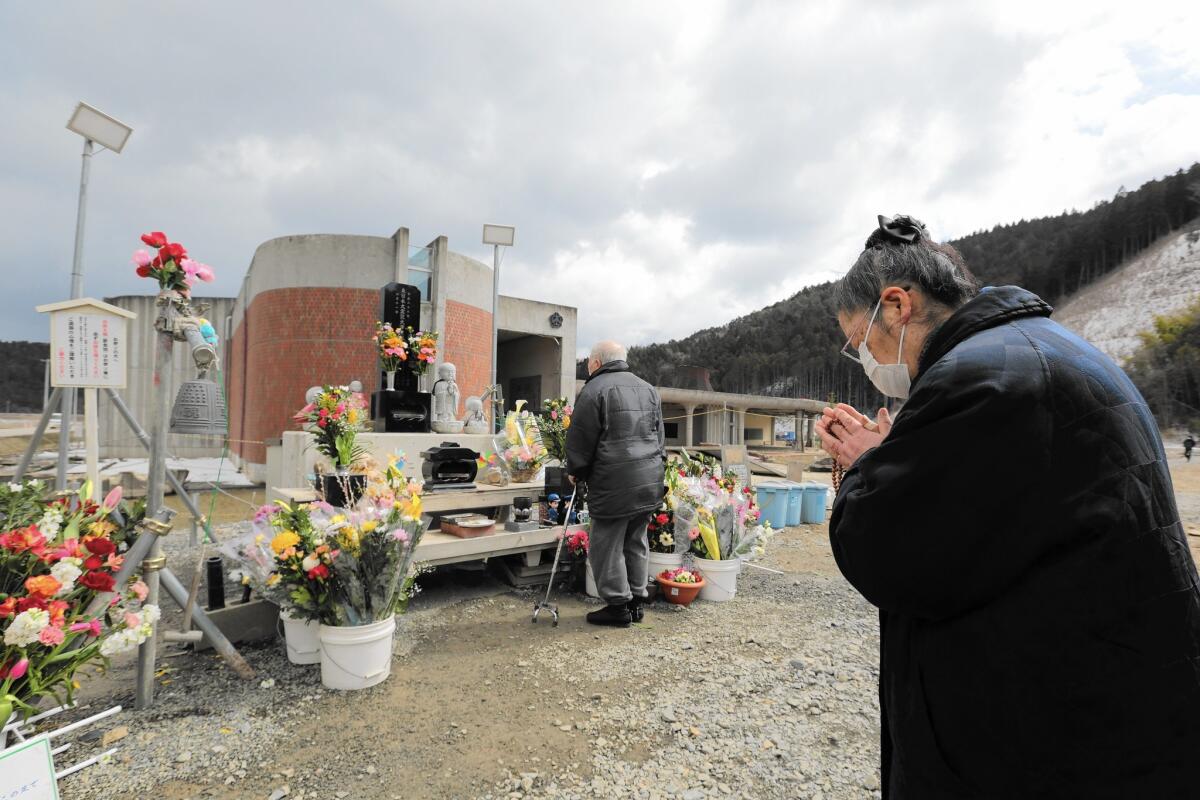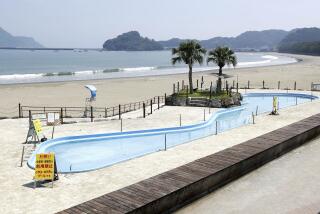In hard-hit Okawa, Japan, life remains a struggle after 2011 tsunami

Reporting from Ishinomaki, Japan — More than 3 1/2 years after a 50-foot tsunami rushed up the Kitagami River, inundating houses and farms and destroying everything in its path, the road to this city’s port remains unusable. Farmland, tainted by a massive influx of seawater, is still being restored. Hundreds of people remain in shabby temporary housing, with no exit in sight.
The only business that really seems to be booming is what is being called “disaster” tourism related to the magnitude 9 earthquake of March 11, 2011. Unending streams of visitors arrive here seeking a glimpse of the devastation zone.
The hardest-hit areas in this once-picturesque coastal area have lost of a third of their population, according to some calculations. Yet many visitors are attracted to the area where 74 of the 108 students at Okawa Elementary School died; some even deem the latter site a psychic hot spot.
As Japan continues its slow crawl back from the devastation, Ishinomaki, and its Okawa district in particular, is among the places struggling the most.
Nationwide, more than 93,000 people still live in temporary housing, according to government statistics. In the Okawa district, which has about 2,300 residents, about 200 families remain in temporary housing.
According to Japan’s Reconstruction Agency, 301 of 319 damaged fishing ports have been repaired. But Okawa’s port remains untouched.
A large portion of the Okawa area is still designated a “danger zone” and residents cannot reclaim their property. The areas closest to the mouth of the river are blanketed by seawater that has seeped inland because the land has sunk 2 to 5 feet.
Temporary housing has been extended to 2017 as the government has delayed plans to move people into nearby permanent housing by 2015.
“I think I might be stuck here longer because I’m not sure if we’ll be able to move in three years,” said Kazuko Hamahata, 79, who described the conditions in temporary housing as cramped and difficult.
Taisei Satake, head monk at the local Soutoushu Chouseizan Kaizouan temple, said most residents lost everything in the quake and ensuing tsunami and are at the mercy of the government in terms of rebuilding.
Psychologically, he said, some survivors have been unable to overcome their losses and resume their lives. Some continue to search for the remains of their lost relatives.
A 2012 government-funded Tohoku University study on the health conditions of evacuees in temporary housing in Ishinomaki found an increase in obesity and sleep impairment. Effects on the elderly were particularly severe, the study found.
“I’m not able to sleep some nights,” said Teruo Takahashi, 67, vice chairman of one of Okawa’s neighborhood community organizations.
Some also suffer from such illnesses as asthma, he said, exacerbated by mold in their tiny living quarters.
Adding to the woes, the Tohoku University study found there were few job opportunities for aging residents who worked in farming or fishing before the disaster.
Officials have been trying to revive the farmland by spending more than $90 million to bring in dirt from afar to cover the seawater-tainted ground, said Mikio Hamahata, who worked for the city government until last year. “I wonder if it is a good use of funds,” Hamahata said.
On the seas, only a few local fishermen have begun operating again independently since the disaster. Infrastructure rebuilding for other industries also has been slow, with only two companies starting up.
The first business to restart in the area was Miyagi Risuta Okawa, which receives government subsidies for its 10 local employees to cultivate rice and chrysanthemums.
Tobu Kankyo Inc., a tire recycling company, is investing more than $4.5 million in the other business: growing produce and generating green energy in Okawa. Kazutaka Sato, who lost a child to the tsunami, is employed by the company to grow hydroponic leafy vegetables in a 20,000-square-foot greenhouse.
Sato hopes the 13-employee business will generate annual sales of about $370,000. The company is in the process of installing solar panels and plans to generate 1.2 megawatts of power annually.
For many here, the high number of deaths continues to cast a grim shadow.
The government says 15,889 people died and 2,601 people remain missing nationwide.
According to some local estimates, the waves swallowed 377 residents of the Okawa district and 36 were never found, including four children.
Sato’s youngest son, Yuki, 12, was among the victims.
Yuki was seeking to evacuate from the schoolyard at Okawa Elementary when the tsunami hit 50 minutes after the earthquake. Ten days later, Sato found his son’s corpse.
“For us, it was good news for a body to be found — so many were missing,” said Sato.
In March, Sato and 28 other parents joined a class-action lawsuit seeking damages from the school district for the deaths of their children. The families want to know why the children were not taken to safer, higher ground nearby.
Sato’s wife and two other children survived, along with their house. But struggling to cope with his grief, he was not able to return to work for months. Instead, he dedicated himself to searching for bodies of others and clearing debris.
Takahashi, of the neighborhood community group, said 190 families in the Okawa Elementary School district lost a family member. There are only 10 families that did not lose anyone, he said.
The tourists who come to see the school these days are upsetting residents, said Satake, the monk. But some seek to focus on hope of recovery.
Tomoya Kinoshita, 26, wants to revive his family’s inn, Matsubara-so. It was started by his mother’s relatives, and his mother, Emi, 46, managed it as the second-generation owner until she disappeared in the tsunami.
The inn itself was wiped away without a trace.
Kinoshita has moved back to the area, although not to the location where the inn stood, and has opened a restaurant using the Matsubara-so name as he makes plans to revive the inn.
“I don’t know if I’ll be able to open an inn as large as my mother’s,” he said. “But I think it would make her happy for me to carry on the family legacy.”
Nagano is a special correspondent.
More to Read
Sign up for Essential California
The most important California stories and recommendations in your inbox every morning.
You may occasionally receive promotional content from the Los Angeles Times.










